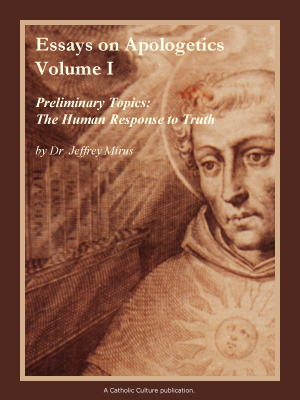False advertising in Vatican document on Catholic identity in schools
By Phil Lawler ( bio - articles - email ) | Mar 31, 2022
This week the Congregation for Catholic Education issued an Instruction on The Identity of a Catholic School for a Culture of Dialogue. The introduction to the document described it as an “intentionally concise and practical tool.” It is neither.
Concise? The document runs over 11,000 words.
When I worked in Washington at the Heritage Foundation, the president of that think-tank, Ed Feulner, would frequently remind researchers that their work should pass “the briefcase test.” By that he meant that a report should be brief enough so that, if a policy-maker could not digest the material immediately, he would be inclined to put it in his briefcase, to read at home that evening. A heftier tome, Feulner explained, would likely sit on his desk, gathering dust.
This document fails the briefcase test badly. Since its appearance I have spoken with four friends who would ordinarily read an important new Vatican document. Not one had read this one—although one told me that he had “skimmed” it. Two others remarked that they were happy to hear that at least I had read the whole thing; it would save them the trouble.
A document that fails the briefcase test—that is, a document that is not read—cannot function as a “practical tool.” But even for the infinitesimal minority of Catholics who actually plow through this prolix offering, the practical applications will be hard to find.
The Instruction—which stems from a conference organized by the Vatican in 2015 (and it took nearly seven years to produce a report on the conference?!)—refers back to Gravissimum Educationis, and reminds that that Vatican II document, “in line with the ecclesiology of Lumen Gentium, … considers the school not so much as an institution but as a community. Good, good. And the new document reiterates the constistent teaching of the Church that parents are the primary educators of their children. Very good.
So why does this document warn of “a widespread educational emergency”? That phrase is borrowed from a letter Pope Benedict XVI wrote in 2008, in which he laments “the failures we encounter all too often in our efforts to form sound people who can cooperate with others and give their own lives meaning.” The proper response to that emergency—Pope Benedict wrote, and the Congregation for Catholic Education now confirms—is the development of a strong Catholic identity in our Church schools. An excellent point. But how does the new document, as a “practical tool,” tell us to nourish and protect that Catholic identity?
Any Catholic parent with children in parochial schools knows the problem. If Catholic schools fail to offer a distinctively Catholic education—if they become indistinguishable from the public schools, where both the curriculum and the atmosphere grow steadily more toxic for the faith—what recourse do parents have?
The Instruction makes a nod toward that question, saying that “it is necessary for every educational apostolate of Christian inspiration to obtain concrete recognition on the part of the competent ecclesiastical authority. In this way, the faithful are guaranteed that the school of their choice provides a Catholic education.” Yes, but that is precisely the problem. When “competent ecclesiastical authority” in fact does not ensure the Catholicity of Catholic schools, what can the faithful do? This is the problem of Catholic identity in education: a problem that Church leadership has not forthrightly faced.
The new Vatican document spells out the bishop’s duty:
In cases where the term “Catholic” is used illegitimately or is aimed at giving the impression that the school is in communion with the Church, it is the responsibility of the competent diocesan/eparchial Bishop, having heard the school management and leadership and after examining the individual case, to state in writing and, should he deem it appropriate, also publicly with the aim of alerting the faithful, that this is not a Catholic school recognised and recommended by the Church.
Fine. But how often have diocesan bishops taken that dramatic step? How many parochial schools have drifted far from the faith, with no corrective action? A truly “practical” Vatican document would spell out the circumstances under which bishops are obliged to take action, and exhort the shepherds to protect their flocks. Not so this Instruction.
Instead the Congregation for Catholic Education explains that “Catholic identity” is a complex concept. The document warns against a “reductive interpretation of catholicity” and “the ‘narrow’ Catholic school model.” It reminds us that Pope Francis has proposed “the high road of unity over conflict.” In short the document gives bishops new excuses for ignoring problems in Catholic schools, new Vatican verbiage to cite as they explain why parental protests will go unheeded.
If parents should be recognized as the primary educators of their children—and that has been the clear teaching of the Church across the years—then when questions arise about a school’s Catholic identity, a bishop’s first instinct should be to rush to support faithful Catholic parents. In practice, however, bishops usually choose to support the school administrators, helping them to ward off the concerned parents. If the new Instruction is used as a “practical tool” by anyone, I fear it will be by bishops who want to avoid the tough responsibility of ensuring Catholic identity in Catholic schools.
All comments are moderated. To lighten our editing burden, only current donors are allowed to Sound Off. If you are a current donor, log in to see the comment form; otherwise please support our work, and Sound Off!
-
Posted by: Lucius49 -
Apr. 01, 2022 8:36 PM ET USA
Mr. Lawler rightly points out the document is prolix and flawed; plus there’s been no will in the Holy See and episcopate to insist on Catholic identity for years! The Holy See beginning with Paul VI stopped insisting on it. Paul VI abandoned Cardinal O’Boyle when he disciplined CU theologians in their rejection of Humanae Vitae. Many so-called Catholic schools work against the Faith serving secularism/pc ideology. This document like sadly Ex Corde Ecclesiae will be be DOA due to lack of will.
-
Posted by: TheJournalist64 -
Apr. 01, 2022 6:43 PM ET USA
I've often commented that the current pope never uses 200 words when he can use 1000 in his documents. They are often unreadable because of that. It appears that this dicastery has taken his example and used it as they expect he wants, to make it impossible to use.
-
Posted by: feedback -
Mar. 31, 2022 5:39 PM ET USA
In 2018, Archbishop Charles Thompson removed the designation "Catholic" from Brebeuf Jesuit Preparatory School in Indianapolis after one of the male teachers "married" a man and the school refused to fire him for a breach of contract. The Jesuit school appealed the Archbishop's decision to the Vatican and three years later the case remains pending and the school retains "Catholic" in its name. Jesus said, "And if a house be divided against itself, that house cannot stand." [Mark 3:25]








